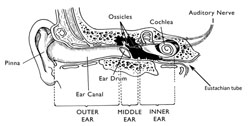35.2 Acute otitis media
Acute otitis media (AOM) is a severe infection of the middle ear (Figure 35.3), lasting less than two weeks. It is very common in babies and young children, but is rarely seen in adults. Studying this section will help you to prescribe the necessary treatments to a child with AOM, and know when to make a referral of more complicated or persistent cases for further investigation and specialist treatment at a higher level health facility.
It may surprise you to learn that infection inside the ear is classified as a URI. The explanation can be found in Figure 35.3. In each ear, the middle and inner ear are connected to the upper respiratory tract by a tube called the Eustachian tube, which leads to the pharynx. You can sometimes hear a soft ‘pop’ in your ears when you swallow as the pressure wave created by swallowing travels up the Eustachian tubes. Upper respiratory tract infection in the pharynx and tonsils can reach the middle ear if the infectious agents spread upwards along the Eustachian tubes.
35.1 What are acute respiratory tract infections?

